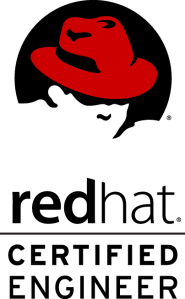Red Hat Enterprise Linux 7-RHCE Syllabus
RH124 Red Hat System Administration I

Red Hat SystemAdministration 1(RH124) is designed for IT Professionals who are new to Linux.This course will actively engage students in task focused activities, lab-basedknowledge checks, and facilitative discussions to ensure maximum skill transferand retention. In addition GUI based Environment will be featured to build onthe student’s existing technical knowledge, while command line concepts will beintroduced to provide a foundation for students planning to become full timeLinux system administrator.
I ) Red Hat System Administration I (RH124) Course Outline
Access the command line
Log in to a Linux system and run simple commands using the shell.
Manage files from the command line
Copy, move, create, delete, and organize files from the bash shell prompt.
Getting help in Red Hat Enterprise Linux
Resolve problems by using online help systems and Red Hat support utilities.
Create, view, and edit text files
Create, view, and edit text files from command output or in an editor.
Manage local Linux users and groups
Manage local Linux users and groups, and administer local password policies.
Control access to files with Linux file system permissions
Set Linux file system permissions on files and interpret the security effects of different permission settings.
Monitor and manage Linux processes
Obtain information about the system, and control processes running on it.
Control services and daemons
Control and monitor network services and system daemons using systemd.
Configure and secure Open Ssh service
Access and provide access to the command line on remote systems securely using Open Ssh.
Analyze and store logs
Locate and accurately interpret relevant system log files for troubleshooting purposes.
Manage Red Hat Enterprise Linux networking
Configure basic IPv4 networking on Red Hat Enterprise Linux systems.
Archive and copy files between systems
Archive files and copy them from one system to another.
Install and update software packages
Download, install, update, and manage software packages from Red Hat and yum package repositories.
Access Linux file systems
Access and inspect existing file systems on a Red Hat Enterprise Linux system.
Use virtualized systems
Create and use Red Hat Enterprise Linux virtual machines with KVM and libvirt.
II) Red Hat System Administration II (RH135) Course Outline
Automate installation with Kickstart
Automate the installation of Red Hat Enterprise Linux systems with Kickstart.
Use regular expressions with grep
Write regular expressions that, when partnered with grep, will allow you to quickly isolate or locate content within text files.
Create and Edit text files with vim
Introduce the vim text editor, with which you can open, edit, and save text files.
Schedule future Linux tasks
Schedule tasks to automatically execute in the future.
Manage priority of Linux processes
Influence the relative priorities at which Linux processes run.
Control access to files with access control lists (ACL)
Manage file security using POSIX access control lists.
Manage SELinux security
Manage the Security Enhanced Linux (SELinux) behavior of a system to keep it secure in case of a network service compromise.
Connect to network-defined users and groups
Configure systems to use central identity management services.
Add disks, partitions, and file systems to a Linux system
Manage simple partitions and file systems.
Manage logical volume management (LVM) storage
Manage logical volumes from the command line.
Access networked attached storage with network file system (NFS)
Access (secure) NFS shares.
Access networked storage with SMB
Use autofs and the command line to mount and unmount SMB file systems.
Control and troubleshoot the Red Hat Enterprise Linux boot process
Limit network communication with firewall
Configure a basic firewall.
III) Red Hat System Administration III (RH255) course outline
Control services and daemons
Review how to manage services and the boot-up process using systemctl.
Manage IPv6 networking
Configure and troubleshoot basic IPv6 networking on Red Hat Enterprise Linux systems.
Configure link aggregation and bridging
Configure and troubleshoot advanced network interface functionality including bonding, teaming, and local software bridges.
Control network port security
Permit and reject access to network services using advanced SELinux and firewalld filtering techniques.
Manage DNS for servers
Set and verify correct DNS records for systems and configure secure DNS caching.
Configure email delivery
Relay all email sent by the system to an SMTP gateway for central delivery.
Provide block-based storage
Provide and use networked iSCSI block devices as remote disks.
Provide file-based storage
Provide NFS exports and SMB file shares to specific systems and users.
Configure MariaDB databases
Provide a MariaDB SQL database for use by programs and database administrators.
Provide Apache HTTPD web service
Configure Apache HTTPD to provide Transport Layer Security (TLS)-enabled websites and virtual hosts.
Write Bash scripts
Write simple shell scripts using Bash.
Bash conditionals and control structures
Use Bash conditionals and other control structures to write more sophisticated shell commands and scripts.
Configure the shell environment
Customize Bash startup and use environment variables, Bash aliases, and Bash functions.
Linux containers preview
Preview the capabilities of Linux containers, Docker, and other related technologies in Red Hat Enterprise Linux 7.
Prerequisites/Candidate profile
You can directly join the RHCE training which is covering the RHCSA topics also.
Student should know: • Basic operating level knowledge of Microsoft Windows OS. • Recommended – Computer Hardware basic knowledge • Recommended – Internet browsing and emailing.
